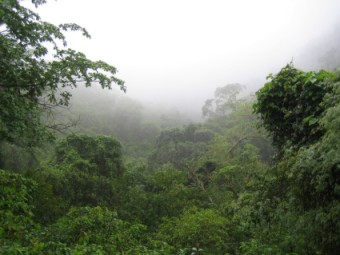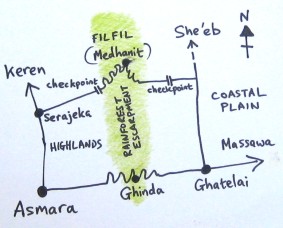|
Birdwatching in Eritrea Filfil Rainforest |
|||
| Home |
Introduction Sometimes called 'Seminawi Bahri', 'Filfil Solomuna' or 'the Green Belt of Eritrea', Filfil Rainforest, as it's known locally, is an amazing enigma. Located on the same line of latitude as the Sahel, Filfil is the most northerly rainforest in Africa. What makes it even more remarkable is that it has survived in tact during periods when much of Eritrea suffered from severe deforestation. The forest extends for about 40km along the eastern escarpment of the highlands between the altitudes of 700 and 2000m, varying from mixed evergreen and deciduous trees at lower altitudes to African Olive and African Pencil Cedar (Juniperus procera) at higher altitudes. The forest gets its moisture from the warm, humid air that blows in on the prevailing winds from the Red Sea which condenses as it is forced up the Rift Valley escarpment, providing cloud rainforest and 5-7 months of wet weather each year, in two periods from October to February and then from April to May. These climatic conditions provide a wide range of habitat types and fragile ecosystems in a very small area which could potentially harbour undescribed species of insects, plants and possibly even animals.
Until 2001 there was no easy access to this rainforest; the road was unsurfaced and poorly maintained. However, the mammoth task of repairing and upgrading this road was completed in 2006, and now Filfil is easily accessible, with the best road in the country! A round trip can be done in a day (although two or three is recommended), travelling from Asmara to Massawa and back, going down via Filfil, and up along the main Asmara-Massawa road via Ghinda. The journey can be undertaken in a few hours in any type of vehicle, even on bicycle (we recommend downhill only!), and is one of the most incredible scenic journeys you are likely to experience in your life. If possible, you should aim for a full day's birdwatching here. There is a friendly hotel in the middle of the forest where you can spend a night or two if you would like to explore Filfil's secret valleys in more detail.
Getting there Filfil is about 40km north east of Asmara. From Asmara, take the Keren road north for about 27-30km until you reach the town of Serajeka, where there is a clearly marked turn off to the right, which you take. This road then turns east and after about 10 more kilometres you arrive at the checkpoint that marks the entrance to Filfil. You will need a special permit to visit Filfil (see Travel & Accommodation page for more information), but this can be easily organised in Asmara. Upon entering Filfil National Park your travel permit will be inspected, and on leaving you will have to pay a small fee towards the National Park.
The road then begins winding down from 2400m to 700m in about 35km. There are reportedly 42 switchbacks, and at every bend in the road there are incredible views. It's a good idea to make sporadic stops on the way down to check out the bird species. You will pass several Recreation Sites, including Mogo (where there is a small checkpoint) and Sabur, which is good for several of the Abyssinian endemics. However, the best place to birdwatch is at Medhanit, located at about 1000m, bang in the middle of the most mature rainforest. At Medhanit, you will find a hotel and restaurant (more about that in Accommodation below), and very friendly people. It is also quiet here, with only a couple of vehicles an hour, so you can happily wander along the road which gives good views into the understorey on one side and the forest canopy on the other. About 10 minutes' drive after Medhanit, the road finally reaches the bottom of the escarpment and the village of Filfil. There is a wide river here, often dry (at least on the surface), and a large army camp, so avoid poking around with your binoculars or camera without first checking with the soldiers, who are usually very friendly. The road then passes through the foothills and out onto the coastal plain, the vegetation changing in a matter of kilometres from rainforest to semi-desert. After a few kilometres of flat road, you will reach the bottom checkpoint, where you will have to pay on leaving the park. A few kilometres further and you will reach a T-junction. Turn right here to head towards Ghatelai, a small town 10-20km further south. Here there is another T-junction as you meet the main Asmara-Massawa road. Turn left for Massawa, and right for Asmara via Ghinda, where there is also some reasonable rainforest, albeit significantly more degraded than that at Filfil.
If you are coming the other way (i.e. from Massawa to Asmara via Filfil), obviously follow the directions in reverse!
There are buses that go along the Filfil road, although only one each way every day. The bus leaves the Keren Bus Station in Asmara at about 6:30-7:00am (get there by 6am to be sure of a seat). It arrives at Medhanit (the middle of the rainforest) at 9:30-10:00am, where it usually stops for a tea break. The buses going up the hill usually pass through Medhanit at around midday, so it is possible to spend the 24 hours at Medhanit and then travel back to Asmara on the uphill bus. More information about bus travel can be found on the Travel and Accommodation page.
Accommodation As mentioned above, if you have time, we recommend staying overnight at the Medhanit Recreation Centre. There is a basic, but clean and well-furnished hotel there (bearing in mind how remote the location is) with a restaurant, good food and drink. A generator provides electricity for a few hours in the evening. No running water (unless you count the precipitation!). The staff are extremely friendly and the security guard, Amare, will be more than happy to take you for a birdwatching stroll along the road if you don't want to go unaccompanied. The price for a room is 200Nfa per night. There are 2 twin rooms and one single (5 beds total). Telephone: 07169215 to make a reservation.
Habitat Types Mixed evergreen and deciduous rainforest dominated by Combretum. African Olive (Olea africana) forest. African Pencil Cedar (Juniperus procera) forest. Riparian woodland. Agricultural land, esp. maize. The BirdLife International website mentions the vegetation types in detail, which is quoted here:
Birdwatching Highlights of Filfil Filfil has many of the Abyssinian endemics, including White-cheeked Turaco, Abyssinian Woodpecker, Black-winged Lovebird, White-throated Seedeater, Banded Barbet, Ethiopian Oriole, and several of the semi-endemics; Ruppell's Robin Chat, Erckel's Francolin (common by the road), White-rumped Babbler and Brown-rumped Seedeater. Three species of hornbill can be seen here; Hemprich's Hornbill (above 1000m), Northern Red-billed Hornbill (below 1000m) and African Grey Hornbill (below 800m). Little Rock Thrush is common by the road, and Eastern Grey Plantain Eater is common down in the valley. Many rainforest species are here including Narina Trogon, Tropical Boubou, African Paradise Flycatcher, Northern Puffback, Brown Woodland Warbler and White Helmet Shrike. Nubian Woodpecker is the common woodpecker species below 1200m. Raptors include Black Kite, Augur Buzzard, African Hawk Eagle, Tawny and Steppe Eagle, African Goshawk, Shikra, Lesser Kestrel and Common Kestrel. Larger mammal species include the common Greater Kudu, Bushbuck, Warthog and Leopard.
Where to Watch Birds
Sabur Recreation Centre Sabur is located at approx. 1300m, and is low enough to have some good forest and high enough for several of the Abyssinian endemics to be found. See above for directions. There is a restaurant here, but no accommodation. There are quite a lot of dead trees here, so it is one of the best places in Eritrea to find the scarce Abyssinian Woodpecker. White-cheeked Turaco and Ethiopian Cisticola are common here. There are several terraced hills behind the recreation centre where the forest isn't too dense and it's easy to explore and find birds. You can also walk uphill and downhill along the main road, which is usually very quiet.
Medhanit Recreation Centre See above for directions and accommodation. The hotel/restaurant is a good base to work from. It's at an altitude of about 1000m in the thick of the most mature forest. There are few paths leading off into the forest anywhere along the road, and if it's wet you'll quickly get saturated. So, as the road is quiet and gives very good views both over the canopy and into the undergrowth (on different sides), the best way to see the birds is by taking a stroll along the road. If you go up the hill, you'll see the more montane species, including most of the endemics mentioned above and below. If you go down the hill, you'll see different species typically associated with the coastal lowlands. Following the road down (after 2-3km) you eventually come to an area where the forest has been cleared, and there is a path cutting across some agricultural land on the right. It is a short cut down to the Filfil valley. Along here you'll find different species again, associated with more open woodland. For more adventurous birders, at the first stream valley a few hundred metres uphill of Filfil, there is a track that cuts down the embankment to the left, leading down to the stream valley. This path is only recommended during the dry season.
Filfil Further down the valley, where the road crosses a wide (often dry) river is the village of Filfil. There is quite a big military presence here, so be sure to ask permission before birdwatching. As with at Medhanit, you get good views into the forest by walking along the road, just uphill of Filfil, where there are some very large trees. The agricultural land around the river harbours different species to those found in the forest. If you can get down to the river (several paths link it to the road), there are often waders, Hammerkop, heron species and other species associated with riparian woodland.
Birds Hammerkop, Common Kestrel, African Goshawk, Shikra, Steppe Eagle, African Hawk Eagle, Long-legged Buzzard, Augur Buzzard, Erckel’s Francolin, Speckled Pigeon, African Olive Pigeon, Red-eyed Dove, Dusky Turtle Dove, African Collared Dove, Bruce's Green Pigeon, Blue-spotted Wood-Dove, Namaqua Dove, Black-winged Lovebird, White-cheeked Turaco, Eastern Grey Plantain Eater, Montane Nightjar, Plain Nightjar, Little Swift, Speckled Mousebird, Narina Trogon, Purple Roller, European Bee-eater, Blue-breasted Bee-eater, Black-billed Wood-hoopoe, Hemprich's Hornbill, Northern Red-billed Hornbill, African Grey Hornbill, Black-billed Barbet, Yellow-breasted Barbet, Banded Barbet, Lesser Honeyguide, Abyssinian Woodpecker, Nubian Woodpecker, Barn Swallow, House Martin, African White Wagtail, Grey Wagtail, White-rumped Babbler, Common Bulbul, Song Thrush, Mountain Thrush, Ruppell's Robin Chat, Little Rock Thrush, Fork-tailed Drongo, Golden Oriole, Ethiopian Oriole, Fan-tailed Raven, Grasshopper Warbler, Marsh Warbler, Chiff Chaff, Willow Warbler, Brown Woodland Warbler, Blackcap, Whitethroat, Ethiopian Cisticola, Grey-backed Camaroptera, Tawny-flanked Prinia, African Paradise Flycatcher, Black-headed Batis, Red-tailed Shrike, Northern Puffback, Tropical Boubou, Black-crowned Tchagra, White Helmet Shrike, Red-winged Starling, Chestnut-bellied Starling, Greater Blue Eared Starling, Red-billed Oxpecker, Variable Sunbird, Abyssinian White-eye, Montane White-eye, Grey-headed Sparrow, Ruppell's Weaver, Baglafecht Weaver, Red-cheeked Cordon Bleu, Crimson-rumped Waxbill, Yellow-bellied (Swee) Waxbill, African Citril, Streaky Seed-eater, White-throated (or Yellow-rumped) Seed-eater, Brown-rumped Seed-eater, Ortolan Bunting
The Birdlife International website also includes: Arabian Bustard, Rouget's Rail, Slender-billed Starling and Shining Sunbird, although these species have not recently been confirmed in the area.
|
||
| Eritrea Information | |||
| Abyssinian Endemics | |||
| Bird Checklist for Eritrea | |||
| Travel & Accommodation | |||
| In Italiano | |||
| Photos | |||
| Other Wildlife | |||
| Asmara Birdwatching | |||
| Filfil Birdwatching | |||
| Adi Keih Birdwatching | |||
| Massawa Birdwatching | |||
| Dahlak Islands Birdwatching | |||
| Elabered / Keren Birdwatching | |||
| Gash Barka Birdwatching | |||
| Contacts and Services | |||
| Links | |||
| Children and Schools | |||
|
|
|||
|
|
|||
|
|
|||

